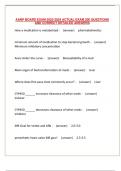Samenvatting
Summary (Elective) TUe (3DEX0) Physics of energy: sources, transport and storage Full Revision Notes
- Instelling
- Technische Universiteit Eindhoven (TUE)
This is a complete summary for the elective course "Physics of energy: sources, transport and storage" at TUe (Eindhoven University of Technology). The course code is 3DEX0. This summary contains all the theory needed and it also includes the corresponding reports for the 4 hands-in-activity.
[Meer zien]













